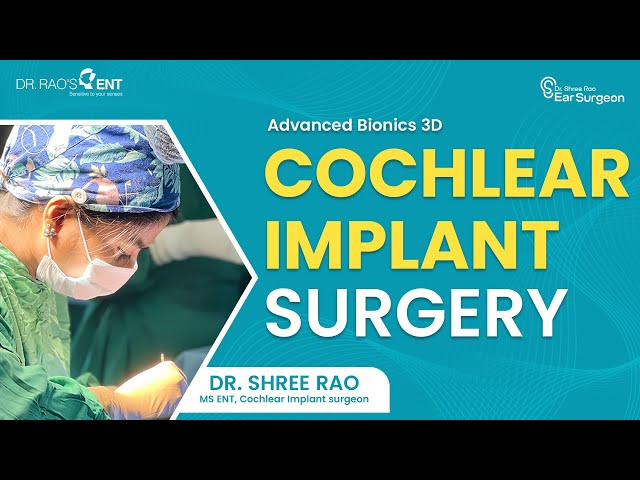Cochlear Implant Surgery Procedure by India's leading Cochlear Implant surgeon, Dr. Shree Rao
Summary of Cochlear Implant Surgery Procedure:
- Skin and subcutaneous tissues are elevated to expose the mastoid bone.
- Incomplete cortical mastoidectomy is performed as the first step in cochlear implant surgery.
- The body of incus is identified, acting as a landmark for locating the facial nerve.
- Posterior tympanotomy is done to access the round window.
- A well is created for the receiver stimulator to be placed and secured with ethibond suture.
- A channel is made for the electrode array to be threaded into the cochlea.
- The Advanced Bionics Ultra 3D model implant is used, with the electrode array slowly threaded into the cochlea over two to three minutes.
- The slim J electrode from Advanced Bionics is used, featuring a gentle electrode curvature and tapered tip for smooth insertion.
- The electrode array insertion is performed slowly to reduce trauma to cochlear structures.
- The round window opening is sealed with periosteum, surgicel, and gel foam.
- The flaps are repositioned, and neural responses are measured.
- The wound is closed, and similar steps are repeated on the other ear.
Cochlear implants have revolutionized the treatment of severe to profound hearing loss, offering a life-changing solution for individuals who do not benefit from conventional hearing aids. The surgery involves a meticulous procedure that requires precision and expertise. Dr. Shree Rao, known as one of the best cochlear implant surgeons in India, excels in performing this intricate surgery, transforming the lives of countless individuals.
Step 1: Preparation and Exposure
The surgery begins with the elevation of the skin and exposure of the mastoid bone. This process allows the surgeon to access the underlying structures necessary for the implantation. An incomplete cortical mastoidectomy is then performed to create access to the middle ear.
Step 2: Identifying Landmarks and Creating Access
One of the critical landmarks in cochlear implant surgery is the body of incus, which acts as a pointer for locating the facial nerve. After identifying the facial nerve, a posterior tympanotomy is performed to access the round window, providing access to the cochlea.
Step 3: Implantation and Electrode Array Placement
A well is created in the mastoid bone for the receiver stimulator to be placed. Simultaneously, a channel is created for the electrode array to be threaded into the cochlea. Dr. Shree Rao utilizes the Advanced Bionics Ultra 3D model implant, known for its advanced features and superior performance. The electrode array is gently threaded into the cochlea over a period of two to three minutes, ensuring minimal trauma to the delicate cochlear structures.
Step 4: Sealing and Closure
Once the electrode array is in place, the round window opening is sealed with periosteum, surgicel, and gel foam. This sealing helps prevent fluid leakage and ensures the stability of the implant. The surgical flaps are repositioned, and neural responses are measured to ensure the proper functioning of the cochlear implant. The wound is then closed, and similar steps are repeated on the other ear if bilateral implantation is required.
Consult Dr. Shree Rao for Cochlear Implant Surgery Procedure:
If you or a loved one is considering cochlear implant surgery, consult Dr. Shree Rao for expert guidance and personalized care. As one of the best cochlear implant surgeons in India, Dr. Shree Rao has the expertise and experience to transform lives through cochlear implants. Don't let hearing loss hold you back – schedule a consultation with Dr. Shree Rao today.







